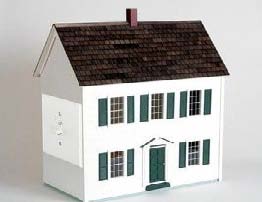Information - guidelines – recommendations for energy efficiency in buildings
What is the climate change?
Climate change is a change in the statistical distribution of weather over large periods of time. The climatic change is one of the biggest challenges we have to face nowadays, as repeated daily by the media. Climate change may be due to physical reasons but also to the human activities with impact on the climate, as f.ex. the change of the atmosphere's composition. Human activity leads to the consumption of huge energy amounts, the production of which is related to the emission of greenhouse gases.
How can we help dealing with climate change?
To get an idea about the energy that can be saved in the building sector of Greece, the mean annual energy saving that can be achieved is of the order of 22% of foreseen conventional consumption of new or under construction public buildings, whereas the annual energy expenses of public buildings overcome the 450 millions €! The application of energy saving measures in the public buildings could decrease the mean annual emissions of carbon dioxide (CO2 ) by 425.000 tons and would correspond to financial benefits of the order of 110 millions €/[year]. At the same time, new jobs would be created. Undoubtedly, the energy efficiency is one of the most effective ways to deal with the climatic change. It has also one more positive aspect: it is a solution which we can all share with!
What your appliances cost you and how much CO2 they emit
Per Hour |
||||||
Appliance |
Power (in Watt) |
|||||
Light bulb 60 W |
60 |
39 |
0.6 |
|||
Energy-saving light bulb equivalent to 60 W normal bulb |
11 |
7 |
0.11 |
|||
Halogen uplighter |
300 |
195 |
3 |
|||
TV set |
80-300 |
52-195 |
0.8-3 |
|||
Stereo/Hi Fi |
55-500 |
36-325 |
0.6-5 |
|||
Laptop & Computer |
80-360 |
52-234 |
0.8-3.6 |
|||
Vacuum cleaner |
700-2000 |
455-1300 |
7-20 |
|||
Hair dryer |
800-2000 |
520-1300 |
8-20 |
|||
Water kettle |
300-3200 |
195-2080 |
3-32 |
|||
Micro wave |
700-2100 |
455-1365 |
7-21 |
|||
Washing machine |
500-3000 |
325-1950 |
5-30 |
|||
Tumble dryer |
500-5700 |
325-3705 |
5-57 |
|||
Dish washer |
700-3000 |
455-1950 |
7-30 |
|||
Electric radiator / heater |
500-3000 |
325-1950 |
5-30 |
|||
Air conditioner |
800-5000 |
520-3250 |
8-50 |
|||
Small electric hot water boiler |
1500-6000 |
975-3900 |
1560 |
|||
Per month |
||||||
Appliance |
Power (in Watt) |
CO2 emissions per month (kg) |
Operating cost per month (€) 2 |
|||
Fridge |
200-700 |
94-328 |
14-50 |
|||
Freezer |
300-700 |
140-328 |
22-50 |
|||
At 650gr of CO2 emissions per 1 KWh
Ligting
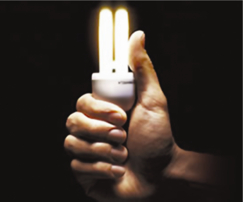 |
In winter, the day is smaller and we have a bigger need for artificial light. The energy that we waste for the lighting reaches the 17%-20% of the electric energy that we consume in our houses. We often consume more energy for artificial lighting then what we really need, since we forget lights turned on in spaces where no one is present. |
Many times we are forced to use artificial light also at during the day time, because of bad space organization (placement of furniture) or bad planning of the building, or simply because we do not pay enough attention. In this matter, the Municipality of Amaroussion reaches the percentage of ..... Whatever the reason is behind unnecessary use of lights, we can simply and with very little effort change our habits and leave lights on only when they are necessary. To this direction, the following actions could help:
• We reorganize our space and we place, if possible, offices and other activity furniture next to windows.
• During the day, we only turn on the light if the light in the specific space where we are is not sufficient.
•We turn off lights each time we leave the house, as well as each time we come out of a room, excluded the case where we have low consumption lamps and pop in and out of a room for periods up to 15 minutes. In this case, from the energy point of view, it is preferable to leave the lights on, than to turn then on and off.
•We replace incandescent bulbs with low consumption light bulbs. One only bulb can decrease the lighting cost by 60 € and the CO2 emissions by 400 kg during its life cycle, which can be up to 10 times longer than the life cycle of usual bulbs (!!) So, the low consumption bulbs can be more expensive, but in the long term could be economically more profitable.
• If we like having a romantic atmosphere, we can light up small candles in the evenings.
Electrical appliances
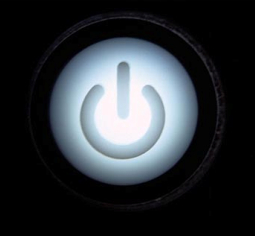 |
Apart from lighting, the limitation of pointless energy consumption of electric appliances can improve our energy footprint and save big amounts of energy, if to be done by all of us. Thus, we can begin with the following simple activities: |
• If we want to avoid the process of turning off each appliance by pressing its power button we put all neighboring appliances in a multi-jack with switch and so we close the switch, when we do not use them.
• We close the appliances from their button and not from their remote control, when we do not use them. A television, that is turned on for 3-hours daily (the mean time that the Europeans watch television daily) and remains on the standby mode for the rest 21 hours, consumes roughly 40% of its energy when on standby mode. Deactivation of electric appliances when they are not used can decrease an electric bill up to 10%.
 |
The same applies for appliances that are permanently on a stand-by mode and do not possess switch. We close them from the multi-jack switch or we remove them from the socket, when not in use. |
In the industrial world residences, the power from the appliances in stand-by situation reaches 15GW, that could be the power for the lighting of 10 millions households! In Greece , roughly 1,5% of electric energy is consumed by electric appliances that are on stand-by mode, corresponding to 600.000 tons of CO2 annually!!!
•We do not use appliances that consume a lot of energy and simultaneously heat the space during the very hot hours (eg electric cooker, iron). As a result we decrease the internal sources of heat and thus the need for air cooling.
• When purchasing electric appliances, we prefer the appliances that bear the Energy Star label. The Energy Star represents a quality label of electric appliances that meet certain energy performance criteria (appliances of low consumption). The European Union has established this particular label for office appliances in the framework of an agreement with the USA government. The goal is to encourage the consumers to buy appliances with this label, in order to save money and energy, and protect the environment. At the same time, energy labeling is a way of putting pressure to manufacturers to crate more efficient appliances . For example, when buying a new computer and a new printer for our house with an estimated lifetime of no more than 5-6 years (average of EU), which will cost us 0,10 euro/kWh, the most efficient ENERGY STAR equipment could save us up to 150-200 Euro of energy consumed by the computer and the printer, without calculating the saving in paper of the printer (paper energy) that could be achieve.
• When purchasing electric appliances, we select high energy performance classes (energy class A, [A]+, [A]++).
• In case of a long absence from our residence, we remove all electric appliances from their sockets.
Refrigerators/freezers
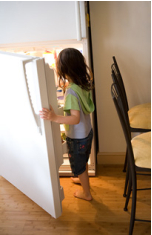 |
We place the refrigerator and/or the freezer as possible away from the oven, the dish-washer, the windows or any other source of heat. Also we place the refrigerator /freezer so that there is a space (at least 10cm) behind and above the appliance, in order that the air circulates unhindered. We keep our refrigerator full, but not too full, so that the door can close and the air can circulate. |
• If our refrigerator does not have an automatic defrost function, we do not forget to defrost it ourselves regularly. A 5mm thick ice layer increases the energy consumption by 30%.
•We always leave the food to cool before placing it in the refrigerator.
• We do not place uncovered dishes/containers in our refrigerator, in order to avoid the evaporation of liquids that could aggravate the function of the appliance.
• We do not forget to close the door of the refrigerator, when we do not use it.
• We maintain the grid at the rear of our refrigerator clean so that there is sufficient air circulation. The energy losses caused because of a dirty grid can reach up to 30% of energy use.
• When we are absent for a long time from the house, we remove all electric appliances from the socket, including the refrigerator. We must not forget that the refrigerators and the freezers are responsible for ~32% of total domestic consumption of electricity at a European level.
• We do not set the thermostat of our refrigerator to the lowest position (coolest) but to the medium or maximum one, since because each degree under the ideal temperature of a refrigerator (1-4º C) does not make any significant difference to the maintenance of our food, while it increases the energy consumption by roughly 5%. Moreover, by setting our refrigerator to the minimum temperature, we will end up by having fresh food for a shorter time, because the food will froze and get spoiled.
Washing Appliances
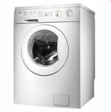 |
In general we should be avoiding high washing temperatures. The modern detergents are so effective, that they clean the clothes and the dishes even in low temperatures. By chosing a program of 40ºC instead of 60ºC, we save 35% of electric energy! We must not forget that washing machines and clothes dryers are responsible for approximately 7.2% of total domestic electricity consumption at a European level. |
• We only start the dish and clothes washers when they are full and not when they are half-full. Thus we save energy (an entire washing-machine instead of two half), water, but also personal time. If, however, we can not avoid it, we select the “economy” program and we always use the ECO button.
• We only use the clothes dryer when it is absolutely essential - each dry circle produces approximately 3 kg of CO2 emissions and we do not overload it (overloading means more time for drying and more electric energy). Physical air drying is preferable, contributes to the longer life cycle of clothes and the energy required is free of charge and does not harm the environment.
• We rinse the dishes before we put them into the dishwasher.
• We use washing-machines during the night. Thus we help reduce the peak demand.
• We use high washing temperatures or pre-wash function only in cases of dishes/containers with burned or dried food residues.
Cooking Appliances
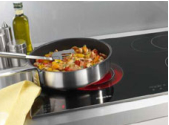 |
We always place a lid over the cooking appliance in use. Through this simple habit, we save an important part of the energy required for the preparation of cooked food. The pressure cookers and steam cookers are also very effective, bacause they save up to 70% of energy and 80% in time! |
• In general, we chose high temperatures in the beginning of cooking and until the liquid starts to boil and afterwards we leave the food to simmer in lower temperatures.
• We boil as much as possible less water. If we boil e.g. exactly the water quantity that is necessary for our tea and we don't fill the boiler up to the top, we could save important amounts of energy. More specifically, if all Europeans boiled the water quantity they really needed, avoiding thus 1 liter of unnecessary boiled water per day each, the energy that would be saved, could provide the electricity needed for the one third of all lightning pillars of European streets.
• We do not preheat the oven in case of baking. If we need soever to preheat the oven, 5-8 minutes is most of the times enough. In any case, the use of hot air in the oven is preferable than its preheating.
Office Appliances
 |
In general we do not buy office and home entertainment appliances of very big dimensions because the bigger the dimensions, the bigger is the energy consumption. We activate the energy saving handlers on our computer and its monitor, so that the computer and the monitor are set to low consumption operation after e.g. 10 minutes of non use. |
•We prefer inkjet printers because they use 95% less energy compared to laser printers.
• We prefer PCs designed for mobile use (laptops) because they consume less energy compared to desktop PCs.
Home entertainment
 |
•We prefer LCD televisions than Plasma televisions. In general we do not buy office and home entertainment appliances of very big dimensions because the bigger the dimensions, the bigger is the energy consumption. |
• When we do not watch television or we don't use the computer etc. we turn them off. If we want some company or something to fill the air, we prefer to use the radio. We should not forget that computers and other electronic appliances are responsible for 10% of total domestic energy consumption at European level, tending to increase.
• We remove the mobile chargers from the socket when we don't charge our mobile phone. Otherwise, chargers consume electricity, which is far from being negligible! According to calculations, 95% of energy is being wasted if we leave permanently the charger in the socket.
Air conditioning/ Cooling- heating comfort
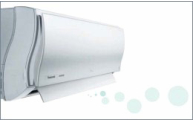 |
Our heating and cooling needs are responsible for the largest amounts of electricity consumed in our houses. According to research, the energy consumption for heating in the European Union in the residential sector reaches 57%. |
The best way to decrease the energy used for cooling purposes is the use of passive systems, such as solar protection and night cooling (passive systems are the cooling systems that cool the space without consuming energy).
Concerning the heating needs, the biggest saving potential is in the insulation of buildings' shells, as well as in the replacement of worn out boilers/heaters by new high efficiency boilers/heaters.
On a personal level, we could do the following:
• We use the air conditioning appliances sparingly. For example, during the warm days we physically cool the building during night hours. The air-conditioning appliances consume big quantities of energy: the average air-conditioning appliance uses 1.000 Watt, emits roughly 650 grams CO2 per hour and costs roughly 0,10 € per hour. An alternative solution is the use of fans. In general, we chose to buy and use air conditioning appliances of high energy performance (higher energy class).
• If we do not have a solar heater, we set the thermostat of our heater to the temperature of 45 o C and we keep it on only as long as it is necessary to warm the water.
• We set our air-conditioning using a wall thermometer at a temperature of no lower than 26 º C during the summertime.
• We always close the windows of our house when we use heating or cooling electric appliances.
• We use window shades, preferably external shading devices, taking into account the solar orientation of a particular building facade: for south-facing windows we prefer horizontal shades, fixed or portable, while for east- and the west-facing windows we prefer vertically placed shades.
• We prefer pale colors to paint the exterior walls, the roofs and the tents.
• We air seal our frames to minimize the heat losses and improve the heat comfort conditions.
• We set the thermostat to lower temperatures during the night or when we are absent for several hours. For each temperature degree reduction, we save 1-2% in energy.
• We turn on the heater a few minutes before using the hot water (in opposite case, the water gets cold before we use it) and we set the thermostat not higher than 50-60 º C.
• We avoid electric showers and we use low-flow shower heads with switch, which are cheaper and provide the same comfort.
Last advice:
Get connected to the network of green electricity! Use as much as you can the renewable energy sources, through f.ex. the installation of solar collectors on the roof of your house. Today, the technology has made great strides and each one of us has a big variety of technological solutions at his/her disposal to cover his/her energy needs (eg biomass boilers, geothermal heat pumps, solar-thermal systems for heating, cooling and hot water, photovoltaic systems for electricity generation). However, only 14% of the electric power of Europe is being produced from renewable energy sources, e.g. wind energy, hydroelectric energy, solar energy, biomass, biogas etc.


